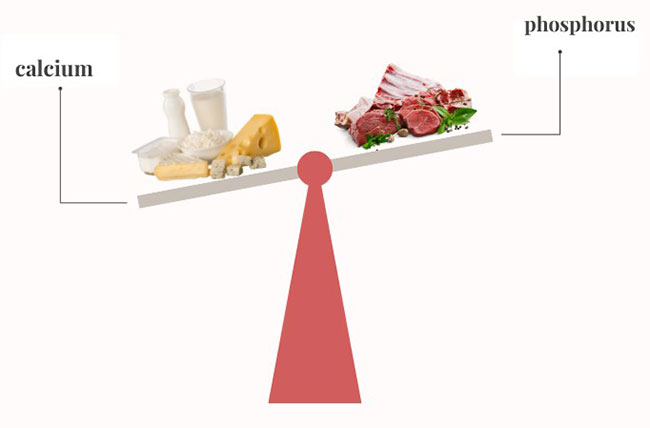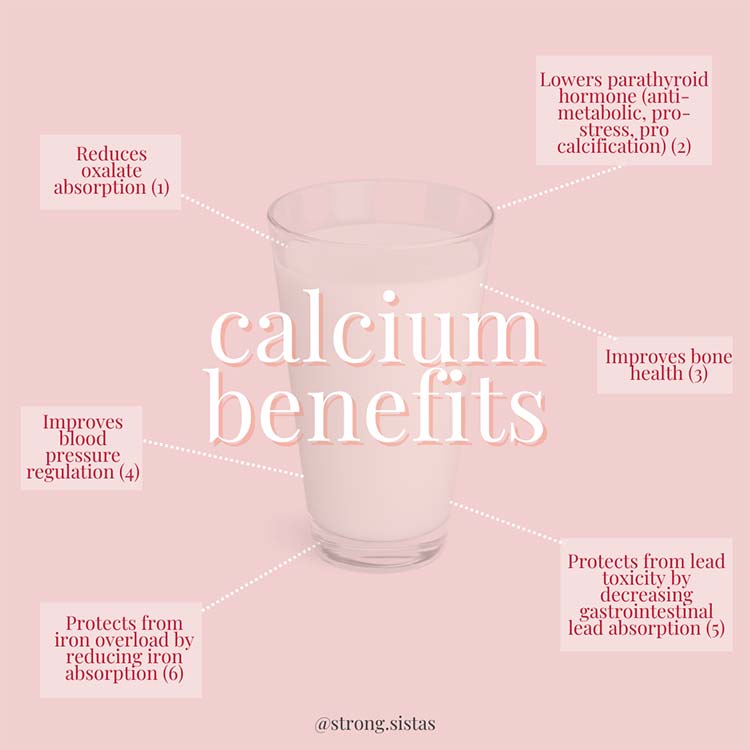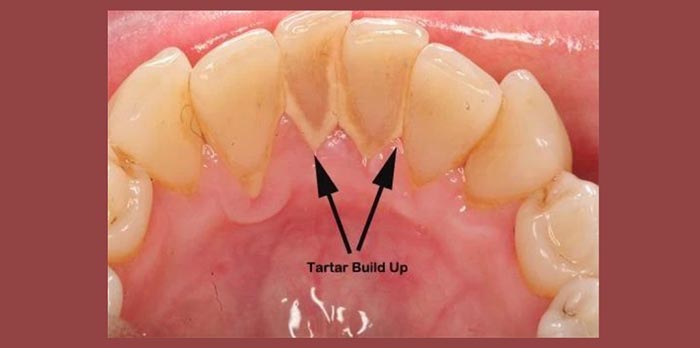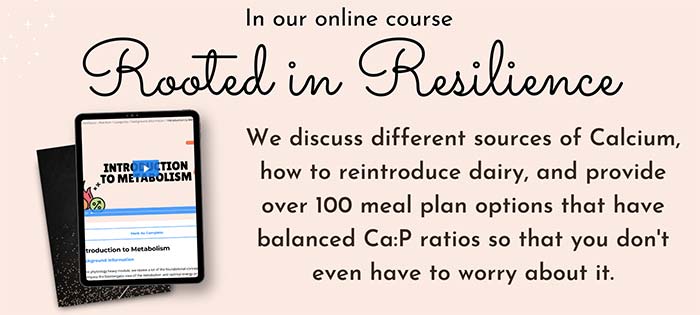How Your Calcium-to-Phosphorus Impacts Your Health
One of the biggest lessons along my health journey is that health is not found at the extremes, and that finding balance is not only more sustainable, but also more health-promoting.
This applies to exercise — balancing working out and providing your muscles with an effective stimulus to elicit change, with enough recovery, food, rest and relaxation. And to food choices, like macronutrients (for ex. balancing protein with enough carbs) and micronutrients (like mineral balance).
Today, I want to briefly touch on why we should consider balancing dietary calcium and phosphorus for optimal long-term health.

From my own experience, working with clients, and course students, many people have very imbalanced calcium to phosphorus ratios. Meaning, they consume very high levels of phosphorus, and low levels of calcium — which is not promoting optimal health.

Western Diets Are High in Phosphorus
It is very easy to get phosphorus in Western diets, as phosphorus is high in meat, grains, and beans. Plus, inorganic phosphorus is high in a lot of preservatives and packaged food (which has a 100% absorption rate1). And so many individuals eat packaged food daily!
“In many Western communities, phosphorus intake is high whereas calcium intake might be low … These types of dietary habit may lead to the lower dietary Ca:P ratios that were recently observed in many countries.
Furthermore, recent evidence from Poland revealed that among 10% of young girls and boys, the dietary Ca:P ratio was lower than 0.25. These results support previous findings among young women in the USA.” ~ Kemi, V. and Lamberg-Allardt, C., 2006
This does “not” make meat and grains “bad” foods (I eat meat and sourdough bread). But we believe these phosphorus-rich foods should be balanced with sufficient dietary calcium. Ideally, the calcium to phosphorus ratio (Ca:P) is close to 1 or above (Ca:P >= 1).
And many people are consuming a Ca:P < 1, especially now that “dairy-free” is all the rage and is promoted as “healthy.”
On one extreme, the carnivore diet, which is an all meat diet, the Ca:P is very imbalanced, as meat is a phosphorus-rich food. On the other extreme, a grain-based diet, the Ca:P is again very imbalanced as grains are another phosphorus-rich food.
Then, searching through more of the “mainstream” (where dairy is “bad”), I searched “dairy-free meal plan” on DuckDuckGo and the first thing that came up was this “1,200 Dairy-Free” meal plan from a popular website, EatingWell. I have so many issues with this meal plan (such as — no one should be eating 1,200 calories).
But after inserting all the meal ingredients into Cronometer, I calculated a Ca:P = 0.3:1, and the total calcium content was just 600 mg! Most people are “not” consuming enough calcium, and have imbalanced Ca:P ratios.
Low Dietary Calcium Leaches Calcium From Your Bones
Calcium gets a lot of bad rep these days, and some fear eating too much of it due to the fear of calcification (a buildup of hardened calcium deposits in tissues that can interfere with function).
But dietary calcium is not the cause of calcification. Instead, low-dietary calcium can be one of the contributing factors. Calcium is so vital for proper function that the body tightly regulates the blood calcium concentration.
“Ca and P have opposite effects on serum PTH (S-PTH) concentration, as dietary P has been found to increase S-PTH concentrations by decreasing serum-ionised Ca concentration and by directly affecting PTH secretion … while Ca administration has been demonstrated to decrease S-PTH … continuous excessive PTH secretion increases bone turnover and releases Ca and P from bone.” ~ Kemi et al., 2009
With inadequate dietary calcium to satisfy the body’s calcium needs, the parathyroid glands release parathyroid hormone (PTH) into the blood to bring calcium level back up to normal by increasing calcium absorption from our food and by dissolving calcium from the teeth and bones. When we don’t consume enough dietarily, calcium gets mined from our skeleton.
Plus, when PTH is elevated from low-calcium intake, we are in a systemic, proinflammatory state that can accelerate the degenerative aging process.2
“It is extremely important to realize that calcium deposits in soft tissues become worse when the diet is low in calcium … It is counterproductive to eat a calcium-deficient diet, since that leads to an increase in intracellular calcium at the expense of calcium from the bones.” ~ Dr. Ray Peat
While there is plenty of literature documenting the human health benefits of a dietary Ca:P >= 1,3 it is not discussed in mainstream or many “alternative” health communities. However, it is well-known, often discussed and well-documented that this Ca:P should remain balanced for other animals such as:
- Dogs4,5
- Cats6,7
- Dairy goats8
The “Nutrient Requirements of Dogs and Cats”9 published textbook recommends a Ca:P ratio of 1.2:1. And the Merck Vet Manual recommends a 1.2-1.5:1 for dairy goats.10

My Personal Experience
I personally saw an improvement with oral health after reversing out of a carnivore diet (very high in phosphorus and usually low in calcium). I not only re-added carbs, but I also added in dairy over time to ensure a Ca:P > 1.
During carnivore (and “dairy-free” keto) days, I would frequently develop hard plaque (aka tartar or calculus) on the inside of my bottom row of teeth. And I would pluck this off my teeth, daily.
Looking back, this was a clear sign that my body was borrowing calcium from the skeleton to maintain calcium homeostasis since we didn’t consume enough dietarily to balance all of that phosphorus. The calcium was “mined” and then released into my saliva. And guess where saliva pools in our mouths? Right on the back side of your front, bottom teeth.

With a balanced Ca:P intake, I no longer get that plaque buildup! These type of dietary changes won’t necessarily be “felt” in the short-term. But they can have profound implications on long-term health. And please don’t let this overwhelm you!
How to Normalize Your Ca:P Balance
There are very simple solutions to regaining Ca:P balance. Here are my top tips:
• Track a typical day of eating in a food tracking app such as Cronometer. The app will tell you your total phosphorus and calcium intake. Divide your total calcium intake by your total phosphorus intake to get your calcium to phosphorus ratio. Ideally this ratio is close to or slightly above 1.
• You may be eating too much meat! Not because of saturated fat. Not because of cholesterol. But meat is a phosphorus-rich food, and we believe it should be balanced with sufficient dietary calcium. So, it can be beneficial to swap some of your meat intake for some dairy to still ensure you eat enough protein while maintaining a balanced Ca:P.
It’s not about avoiding foods that are higher in phosphorus. It’s about including foods higher in calcium to make the overall ratio in balance.
• Currently can’t tolerate dairy? There are other ways to boost your calcium intake! Other favorites include homemade eggshell powder, well-cooked collard greens, pearl powder, or bone meal powder from a trusted source.
I completely understand that keeping track of these type of nutrient ratios can get overwhelming. But if you are looking for additional information on the Ca:P ratio, calcium-rich foods, and how to make sure these minerals remain in balance, check out our course!
In the Nutrition section of our course, Rooted in Resilience, we include over 100 meal plan options, all of which contain balanced calcium to phosphorus ratios — making it easy to implement these important nutrition principles into your busy schedule. We also include an entire module on calcium, the Ca:P ratio, and tips to reintroducing dairy.

Of course, it’s never one thing. Calcium is not the only nutrient that works to suppress the anti-metabolic parathyroid hormone (PTH). We also need adequate levels of magnesium and vitamin D (25-D) to keep the PTH levels in check. Plus, vitamin K2 to ensure calcium goes to the right places (like bones and teeth). It can be overwhelming, but it doesn’t have to be complicated.
Eating real, whole foods, tuning into cravings, and providing adequate fuel is a pretty fool proof formula for regaining control of your health.
Transform Your Health — One Step at a Time


Ashley and her sister Sarah have put together a truly groundbreaking step-by-step course called “Rooted in Resilience.” They have compiled what clearly is the best application of Dr. Ray Peat’s work on Bioenergetic Medicine that I have ever seen.
It is so good that I am using the core of their program to teach the many Health Coaches that I am in the process of training for the new Mercola Health Clinics I am opening this fall. It took these women working nearly full-time on this project for a year to create it.
This has to be one of the absolute best values for health education I have ever seen. If you want to understand why you struggle with health problems and then have a clear program on how to reverse those challenges, then this is the course for you.
It is precisely the type of program I wish I would have had access to when I got out of medical school. I fumbled around for decades before I reached the conclusion they discuss in the course and share with you so you can restore your cellular energy production and recover your health.
|
Select and eat the right foods to heal your metabolism and improve glucose utilization |
|
Balance your hormones to help reduce anxiety, weight gain and sleep disturbances |
|
Use reverse dieting to increase your calories without gaining weight and tanking your metabolism, all while improving your energy levels |
|
Heal your gut for proper immune function, mood and weight management |
|
Tweak your diet and lifestyle habits to improve your mindset and mental health |
|
Crush your fitness goals with ease and get your life back on track |
|
Master the most essential habits for health with bonus guides, including over 100 meal plans to take the stress out of meal time planning and shopping, and so much more! |
Learn more about Rooted in Resilience here.


About the Author
Ashley Armstrong is the cofounder of Angel Acres Egg Co., which specializes in low-PUFA (polyunsaturated fat) eggs that are shipped to all 50 states (join waitlist here), and Nourish Cooperative, which ships low-PUFA pork, beef, cheese, A2 dairy and traditional sourdough to all 50 states. Waitlists will reopen shortly.
Dr Mecola’s Blog
Author: none

